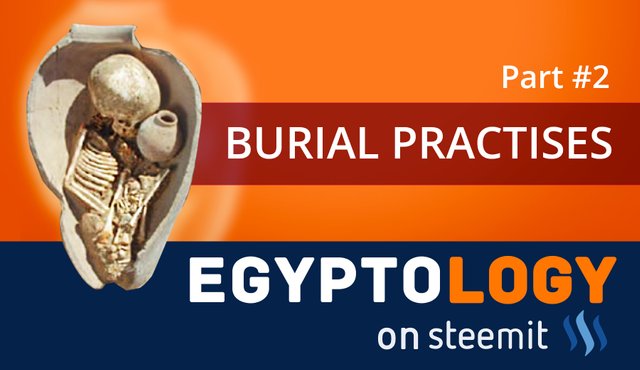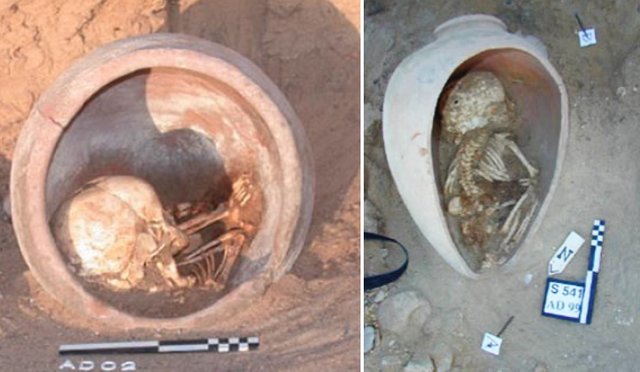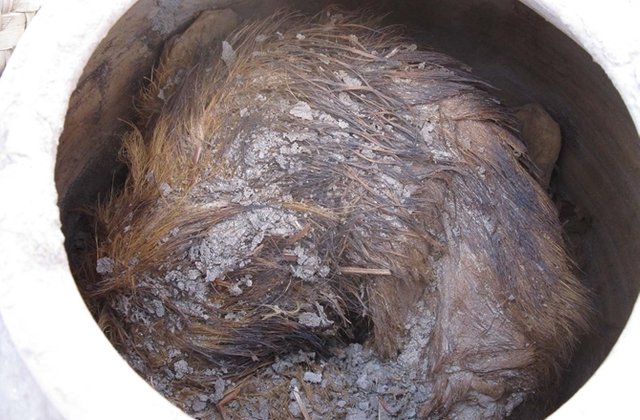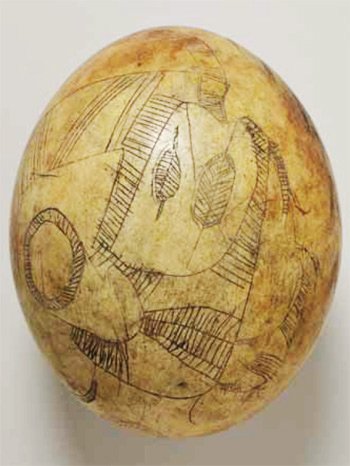EGYTPOLOGY: The mysterious burial practices in Ancient Egypt - Part #2
Today I want to present you some interesting facts about a special burial custom which was not only common in predynastic Egypt (4000–3032 B.C.) but also in many areas of the so-called Levante (geographical area of Palestine, Israel, Jordan etc.), Africa and the Caucasus. The following photograph depicts a so-called ‘pot burial’, sometimes also ‘jar burials’ or ‘urn burials’. (Power/Tristant 2016: 1475)
A Custom of the Poor?
In many cases Archaeologists found the remains of children in such vessels made of pottery, but not in all. Also, the bones of adult led the experts to come to the conclusion that this must have been a custom of very poor people who could not afford a ‘normal’ burial with a wooden coffin and so had to be buried in re-used domestic pottery vessels.
But new research, done by Power and Tristant (see sources below), shed a new light on this tradition, which seems more of an expression of a specific religious belief. The scientists found out, that even in the tombs of high officials the remains of such customs are visible. So, the argument of poverty isn’t valid anymore.
Pot Burials in History
Pot burials were found all around Egypt, such as the sites of Abydos, Adaima, Badari and others, often in desert areas but also in the delta (see map in Power/Tristant 2016: 1477, Fig. 1). It is dating back to the predynastic time, when also other customs were practised: the deceased were often wrapped in linen or animal skin and put in a hole in the desert (which caused the emergence of the first natural mummies, that should later lead to an advanced mummification practice the Ancient Egyptians became famous for). But not only human remains were put into such containers. Also, pets were found this way. See this picture (left) as an example for a perfectly preserved dog that still has its fur!A new Approach
A lot of scholars did intensive research on this subject (see sources for further reading below), and most of them see the funerary containers as re-used vessels from the household and therefore a sign of destitution. But Power/Tristant now offer new ideas by adopting a more holistic approach: the practice of inhumation within a jar in Europe, Africa and Near Eastern now seems to be more an expression of a certain and widespread belief system in the ancient world. In many cases it is not just a round but more a womb-like vessel (see picture above). The pots in which human remains were found, can be seen as the shape of an uterus and could promote the „metaphorical rebirth in the afterlife“ (Power/Tristan 2016: 1478). Some scholars criticise this opinion as „over interpretative“ from an archaeological point of view (Kilroe 2015: 222, cited after Power/Tristant 2016: 1478). But by considering the huge distribution and for a deep understanding of this tradition a broader perspective is required here. The Ancient Egyptians knew that the origin of (human) „life came from an egg“. This is evident in myths, hieroglyphs (Power/Tristant 2016: 1479; Kozloff 2012), see the sign 𓆇 („egg“), and even in the fact that for example ostrich eggs were found in tombs given as grave goods.
Ostrich Eggs in Tombs
On the last subject, I did intensive study years ago. I collected data on all findings of ostrich eggs in tombs over a huge geographical area to find out the reason for this behaviour. Some of them were creatively decorated and while others just seem to function as a (symbolic) vessel for drinking water in the afterlife, which is still practised by tribes in the african desert (Texier et. al. 2010). I could not draw a final conclusion, but there was a clear evidence that eggs did not only play a role in burials of children. I made the same observations as Power/Tristant did regarding the distribution of eggs in tombs: infants, adult men and women, tombs of average people as well as of the elite. I could not prove that eggs were given as a symbol of fertility since they are even found in tombs of old women and men. But the commonness of this tradition makes it more likely to have been deeply anchored in the spiritual consciousness of the people in that time. So I agree with the opinion of Power/Tristant since both can be compared with each other at least on a symbolic respectively metaphorical level. So this specially shaped container indeed could have functioned as a ‘vehicle’ for the transition to the afterlife.Let me know what’s your opinion in the comment section.
Sources:
[1] Kozloff, Arielle, Pharao was a Good Egg, but Whose Egg Was He?, in: Bailleul-LeSuer, Rozenn (Ed.), Between Heaven and
Earth, Birds in Ancient Egypt, Chicago 2012, 59–64.
[2] Power, R., & Tristant, Y. (2016). From refuse to rebirth: Repositioning the pot burial in the Egyptian archaeological record. Antiquity, 90(354), 1474-1488. doi:10.15184/aqy.2016.176
[3] Scalf, Foy, Birds in Creation Myths, in: Bailleul-LeSuer, Rozenn (Ed.), Between Heaven and Earth, Birds in Ancient Egypt, Chicago 2012, 131–132.
[4] Texier, Jean-Pierre et. al., A Howiesons Poort Tradition of Engraving Ostrich Eggshell Containers Dated to 60,000 Years ago at Diepkloof Rock Shelter, South Africa, in: Proceedings of the National Academy of Sciences of the United States of America 107, Nr. 14, 2010, 6180–6185.
[5] Pet Burials: https://www.archaeology.org/news/1606-131205-egypt-abydos-dog-burials
Image sources:
Image used in the editorial picture and Image 1: Power, R., & Tristant, Y. (2016). From refuse to rebirth: Repositioning the pot burial in the Egyptian archaeological record. Antiquity, 90(354), 1480, Fig. 3.
Image 2: Source
Image 3: Teeter, Emily (Ed.), Before the Pyramids, The Origins of Egyptian Civilisation, Oriental Institute Publication 33, 2011, 158.

If you liked this article, please follow me on my blog @laylahsophia. I am a german Egyptologist and write about ancient and contemporary Egypt, history of science, philosophy and life.




Nice information..
@laylahsophia
The dead on a big jar and why they used to put an egg with the dead
Great post :)
Thanks. :)
Very interesting.
Congratulations @laylahsophia, this post is the forth most rewarded post (based on pending payouts) in the last 12 hours written by a User account holder (accounts that hold between 0.1 and 1.0 Mega Vests). The total number of posts by User account holders during this period was 1416 and the total pending payments to posts in this category was $2674.71. To see the full list of highest paid posts across all accounts categories, click here.
If you do not wish to receive these messages in future, please reply stop to this comment.
Amazing job @laylahsophia Followed...
Thank you! :)